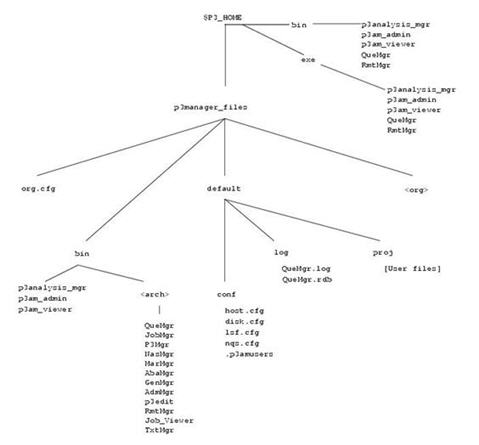XXXXXXXXXXXXXXXXXXXXXXXXXXXXXXXXXXXXXXXXXXXXXXXXXXXXXXXXXXXXXXXXXXXXXXXXXXXXXXXXXXXXXXXXXXXXXXXXXXXXXXXXXXXXXXXXXXXXXXXXXXXXXXXXXXXXXXXXXXXXXXXXXXXXXXXX''"> Directory Structure
The Analysis Manager has a set directory structure, configurable environment variables and other tunable parameters which are discussed in this chapter.
The Analysis Manager directory structure is displayed below. The main installation directory is shown as an environment variable, $P3_HOME =<installation_directory>. Typically this would be or /msc/patran200x or something similar.
where:
<org> (optional) is an additional organizational group and shares the same directory tree as
default yet will have its own unique set of configuration files. See
Organization Environment Variables.
<arch> is one of:
HP700 | - | Hewlett Packard HP-UX |
RS6K | - | IBM RS/6000 AIX |
SGI5 | - | Silicon Graphics IRIX |
SUNS | - | Sun SPARC Solaris |
LX86 | - | Linux (MSC or Red Hat) |
WINNT | - | Windows 2000 or XP |
There may be more than one
<arch> directory in a filesystem. Architecture types that are not applicable to your installation may be deleted to reduce disk space usage; however, all machine architecture types that will be accessed by the Analysis Manager must be kept. Each one of the executables under the bin directory is described in
Analysis Manager Programs.
All configuration files are explained in detail in
Examples of Configuration Files. These include
org.cfg,
host.cfg,
disk.cfg,
lsf.cfg, and
nqs.cfg.
Organization groups and their uses are described in
Organization Environment Variables.
The
QueMgr.log file is created when a Queue Manager daemon is started and does not exist until this time and, therefore, will not exist in the above directory structure unitl after the initial installation. Use of this file is described in
Starting the Queue/Remote Managers respectively. The file
QueMgr.rdb is also created when a Queue Manager daemon is started and is a database containing job specific statistics of every job ever submitted through the Queue Manager for that particular set of configuration file or
<org>. The contents of this file can be viewed on Unix platforms using the
Job_Viewer executable.
Items in the bin and exe directories are scripts to enable easier access to the main programs. These scripts make sure that the proper environment variables are set before invoking the particular program that reside in $P3_HOME/p3manager_files/bin/<arch>.
p3analysis_mgr | Invokes P3Mgr |
p3am_admin | Invokes AdmMgr (Unix only - on Windows this is P3Mgr.) |
p3am_viewer | Invokes Job_Viewer (Unix only) |
QueMgr | Invokes QueMgr (Unix only) |
RmtMgr | Invokes RmtMgr (Unix only) |
Note: | The directories (conf, log, proj) for each set of configuration file (organizational structure) must have read, write, and execute (777) permission for all users. This can be the cause of task manager errors. |

